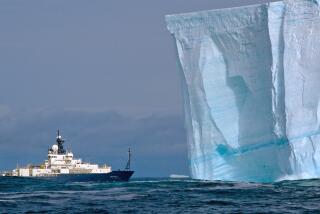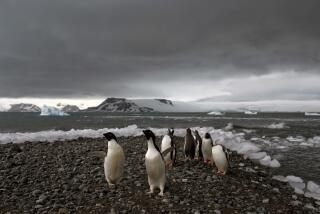Antarctic Summer Opens Season of Opportunity for Scientists
- Share via
MARAMBIO BASE, Antarctica — The bitter Antarctic winter has given way to summer, and scientists from dozens of nations are racing to make use of two months of nearly perpetual daylight and “balmy” temperatures.
For many, this Argentine Air Force base on Seymour Island on the northwestern edge of the Weddell Sea is a port of entry for the Antarctic Peninsula and islands off its coast.
The tiny island, 625 miles across the stormy Drake Passage from the southern tip of South America, has the only airstrip in Antarctica where planes can land year-round without skis.
“We are beginning the busy time,” said Lt. Col. Ricardo Valencia, who arrived in November for a one-year tour as base commander.
Although Marambio is a military base, “we give logistical support to the scientific community,” Valencia said. “Most of the work takes place over the next two months, although we do some all year round.
“The base has about 30 people in winter and adds 50 temporaries in summer, plus about 60 scientists who will be working on projects involving fauna, flora, geology, paleontology and glaciology.”
Argentina, which set up its first research facility in Antarctica in 1904, now operates 12 bases, six of them year-round.
It was one of the 12 original signers of the Antarctic Treaty in 1959. The pact shelved conflicting territorial claims, set aside the continent exclusively for peaceful purposes, banned nuclear testing and explosions, and restricted military activities to supporting scientific work.
“No armed ships or planes are permitted in the area,” Valencia said. “We are here with the idea of promoting peace and the study of the environment.”
Twenty-eight nations operate a total of 45 bases on the continent. A winter population of 600 to 800 swells to 4,000 to 5,000 in summer.
People, supplies, equipment and mail arrive at Marambio aboard air force Hercules C-130 cargo planes. Landing on the 1,200-yard runway often is tricky due to strong winds and cloud cover. Pilots reverse engines on touchdown for maximum braking.
The 25 bright orange buildings and large satellite dish of the Marambio Base sit only a few feet above the sea, which is choked in summer with pieces of pack ice the size of refrigerators and small apartments heading north from the nearby Larsen ice shelf.
Once built of wood and prone to fires in Antarctica’s extremely low humidity, the buildings have been made since 1960 of double panels of light, easily transported plastic sheeting filled with polyurethane insulation. Steel guy wires protect against frequent high winds.
The headquarters building, sometimes referred to by personnel as “Palermo Chico” after a well-to-do Buenos Aires neighborhood, houses living quarters, mess hall, conference room, recreation facilities and a phone booth for calls to the continent.
On a recent day, the outside temperature hovered at 10 degrees above zero. In winter, temperatures of 20 below are more common in this warmest part of Antarctica.
Inside, Dr. Andrea Concheyro, a University of Buenos Aires micropaleontologist, and two companions prepared for a two-month research stint on James Ross Island, 45 miles from Marambio.
Six Italians, a German and half a dozen Argentines were headed for other sites on the peninsula.
Concheyro has spent a total of 14 months over seven summers in Antarctica. Her specialty is the study of the period 65 million years ago, a time when Antarctica was a much warmer place and when many of the Earth’s species, including the dinosaurs, became extinct.
Antarctic research “is a very important professional and personal experience,” she said. “We are small groups and very close friendships are formed.”
This year, she is accompanied by a biologist studying fossilized pollen and a geologist working on glacial form and structure.
Their camp on James Ross Island will be resupplied periodically by helicopter. Food, mostly frozen, will be stored in a snowbank or glacier.
“There are more complaints about the cooks than about the food,” said Daniel Fourcade of the Argentine Antarctic Department, which finances and administers scientific work.
All personnel and scientists receive salaries and a $2,900 monthly bonus for time spent south of the 60th parallel, which marks the northern limit of Antarctica.
Gabriel Pajnossin of the University of La Plata is heading for Argentina’s Jubany Research Base, an hour’s flight from Marambio. He will spend 13 months studying carbon dioxide and its effects on atmospheric warming.
“It is a clean area, free of contamination and ideal for studies,” he said.
Work also continues at Marambio, where “one group is collecting and removing historical garbage,” said Valencia, the base commander, referring to about 80 tons of trash accumulated since the base was founded in 1969-70. “We’re even removing the contaminated mud.”
Several nations, including Argentina and the United States, have been severely criticized by environmentalists for littering over the years.
Visitors are urged not to throw away trash, pick up rocks or bother the penguins and sea birds and to walk only on paths and catwalks.
“We incinerate paper and wood here,” said Bruno della Vedova of Italy’s Trieste University. “But chemicals, oils, lead, lithium and heavy metals used in research all have to be sealed in drums and returned to the continent.”






